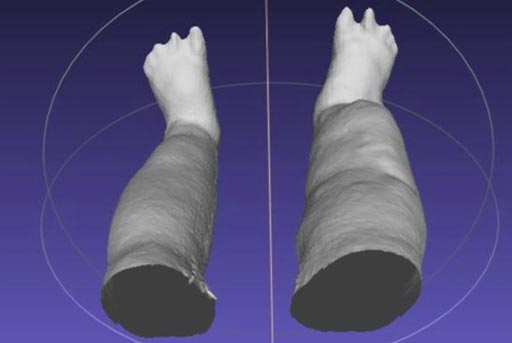Portable 3-D Scanner Assesses Elephantiasis Severity
By MedImaging International staff writers
Posted on 01 Nov 2017
A portable scanning device that measures limb enlargement and disfigurement in patients with elephantiasis can help determine if treatments to reduce swelling are effective.Posted on 01 Nov 2017
Researchers at Washington University (WUSTL; St. Louis MO, USA) have adapted a portable infrared (IR) three-dimensional (3D) scanner developed by LymphaTech (Atlanta, GA, USA) to produce accurate virtual reconstructions of the legs. They then tested the device on 52 patients with varying stages of lymphedema at a clinic in Galle (Sri Lanka), comparing scanner results with water displacement (WD), tape measurement of limb circumference (TMLC), and skin thickness ultrasound (STU) results.

Image: A portable scanning device produces a 3-D reconstruction of swollen legs caused by lymphatic filariasis (Photo courtesy of Michael J. Weiler / LymphaTech).
The system, which using a scanning technology similar to that found in the Microsoft Xbox Kinect video game system, showed nearly perfect correlation with both WD and TMLC. The average time to acquire scanner measurement for both legs was 2.2 minutes, as compared to 17.4, 7.5, and 31.7 minutes, respectively, for WD, TMLC, and STU. The researchers plan to use the device to examine if the antibiotic doxycycline can reduce the severity of swelling. The study was published on October 16, 2017, in The American Journal of Tropical Medicine and Hygiene.
“To our knowledge, this is the first time that infrared 3-D scanning technology has been used in patients with filarial lymphedema. Many patients with swollen limbs often have great difficulty traveling from their homes to the clinic to have their measurements taken,” said senior author Philip Budge, MD, PhD, of the WUSTL division of infectious diseases. “The scanner should make it possible to take extremely accurate limb measurements in the patients' homes or villages, without cumbersome equipment or inconveniencing patients.”
Elephantiasis, or lymphatic filariasis, is a parasitic, mosquito-borne disease marked by severe swelling in the arms, legs, or genitals. The skin may become thicker as well, and the condition may become painful. The changes to the body may harm the affected person's social and economic situation. Three types of worms are known to cause the disease: Wuchereria bancrofti, Brugia malayi, and Brugia timori, which damage the lymphatic system. In 2015 about 38.5 million people were infected, and about 950 million people are at risk of the disease in 54 countries.
Related Links:
Washington University
LymphaTech














